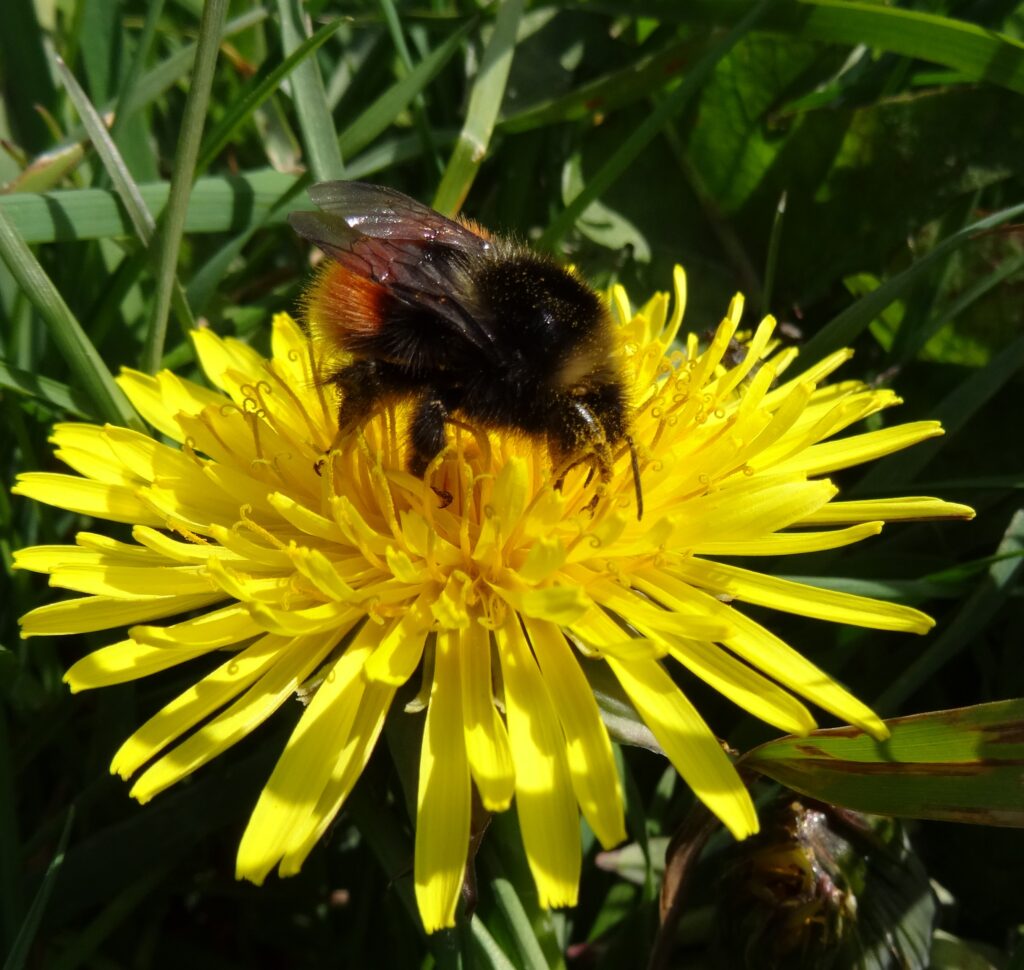Friends of Buxton Station (FoBS) have won a number of awards for their bumblebee conservation work targeting the endangered Bilberry bumblebee – in 2021, FoBS were recognised as one of the Bees’ Needs Champions, awarded by the Department for Environment, Food and Rural Affairs.
With World Bee Day coming up on 20 May, FoBS Chairman Dave Carlisle has compiled the following piece, containing tips and tricks for other community rail and station groups looking to do their bit for bumblebee conservation this summer.

As we enter those first glorious days of spring, more and more queen bumblebees are buzzing into the air as they come out of hibernation. The warm sunny rays have woken up our pollinating friends from their happy slumber. Then they are straight to work, collecting nectar and early pollen to raise and feed their developing colonies of worker bees.
But there is a problem for some queens as they appear in floral deserts, especially those up on the moorland surrounding Buxton!
Of particular concern are the emerging Bilberry bumblebee queens. Threatened with extinction from the UK, this little High Peak treasure awakens in time to pollinate the bilberry plants. Their short tongues are perfect for reaching inside the red bell-shaped flowers to gather energy-rich nectar, whilst their bodies pick up pollen to carry to other bilberry plants. But the bilberry flowers are soon gone, and the early heather isn’t yet in-full-flower.
Living on energy stored months ago, they soon tire out looking for new food supplies. The hungry bees cast about in search of food, further and further from their nests, using up their valuable energy and making the journey home almost impossible.
They often end up in town and need you to help them out by allowing plants (normally thought of as weeds) to flourish. Especially important right now are dandelions – they’re quite open flowers, so good for bees with short tongues as well as those with much longer ones.
There’s a clever school of thought that maintains “a weed is just a wildflower in the wrong place!” Bees can’t differentiate, taking advantage of energy-rich nectar wherever they can, especially if it means survival.
Many native wildflowers can tolerate harsh conditions, so are often the first to show and thrive at this time of year. Before you pull them up as weeds, please stop and think about the bees.
We are not suggesting folk allow their gardens to become overgrown thistle-strewn wastelands or bramble-filled nettle-runs, but rather to fall in love with a few weeds for a few weeks in the corner of their gardens for the sake of the bees: let them flower to provide food before deadheading to stop seed dispersal.
Hang fire with the lawn mower, see what grows. If weeds like dandelions are growing where you really can’t tolerate them, dig them out or spot treat with natural non-toxic products like pelargonic acid – please don’t spray.
The following “weeds” are considered particularly helpful:
- Thistles (Cirsium sp.) – all kinds except creeping thistle
- Dandelions (Taraxacum sp.)
- Sow thistles (Sonchus sp.) all sorts
- Hawkweeds, Hawkbits and Ox-tongues.
- Buttercups (Ranunculus sp), not creeping buttercup
- Daisies (Bellis perennis)
- Poppies (Papaver sp)
- Field Scabious (Knautia)
- Knapweeds (Centaurea sp.) common black knapweed and greater knapweed
- Ragworts (Senecio sp.) but they are toxic to horses and cows!
- Vetches (Vicia sp)
- Speedwells (Veronica sp) especially those with larger flowers e.g. Germander
- Burdocks (Arctium sp.)
- Teasels (Dipsacus sp.)
- Mallows (Malva sp.) especially common mallow and musk mallow
- Bugloss (Anchusa arvensis)
- Forget-me-nots (Myosotis sp.)
- Dead nettles (Lamium sp) especially red dead nettle and white dead nettle
- Hogweeds (Heracleum sphondylium), not the invasive giant hogweed.
- Bramble (Rubus fruticosus)
- Garden culinary mint, if allowed to flower (Mentha sp)
For more information on FoBS’ award-winning conservation work, read the article here.
FoBS have many initiatives lined up to help their local bees once again this year, including more extensive wildflower seed dispersal and more campaigning to raise awareness about the Bilberry Bumblebee. They are also part of the ‘Buzzing Stations’ project, coordinated by the High Peak and Hope Valley Community Rail Partnership, which support station gardens to become bee-friendly habitats. FoBS have worked in partnership with others to help local bees, including collaborations with the Bumblebee Conservation Trust – click here for further gardening advice.